Fire and smoke to honor the Gods#
A Sang puja in the monastery Spituk in Ladakh#
ByAll photos were taken by the author in 1981 and 2000. They are part of his archive "Pictureflood Jones". Someof the Tibetan technical terms of the ritual were taken in their German version from the book "Buddhism in Tibet" by Emil Schlagintweit 1863 (Reprint Delhi 1999) form the library of the author.

Tibetan Buddhism knows several ways to ultimate enlightment, rebirth and nirvana. Several directions which might be called „orders“ and which are not mutually exclusive, have interpreted in their meaning the teaching of Buddha and the pre-Buddhist animistic conceptions, which are associated to the Vajrayana or „thunderbolt path“. The result was a highly complicated theology and mythology with an abundance of colorful ceremonies and rituals. Today most represented is the direction of the reformist-minded Gelukpa or „Yellow Hat“ whose spiritual leader is Dalai Lama. He is regarded as the earthly manifestation of the Bodhisattvas of compassion Avalokiteshvara (tib. sPyan ras gsigs / Tschenresi).
While in Tibet, which was occupied by China in 1949, the cultural revolution of Mao Zedong began to extinguish Buddhism and destroyed irreplaceable cultural treasures or sold it against foreign currency abroad, the western part of the Tibetan ethnic and cultural area has been spared. This part is the Ladakh part of Indian territory and located in the state of Jammu and Kashmir. The monasteries with the monastic communities have survived and can look back on a sometimes over thousand years old unbroken tradition.
One of the monasteries is Spituk which is situated 3300 meters above sea level near the capital of Ladakh, Leh. It is one of the three oldest monasteries (tib. Gompa) and was founded in the 11th century as Njingma Kadampa-settlement („Red Hats“)and taken over by the Gelukpa in the 15th century. Under this „order“ it is the most important in the country. Its intellectual and spiritual qualities are reflected in the name Spituk, which means as much as „exemplary“.

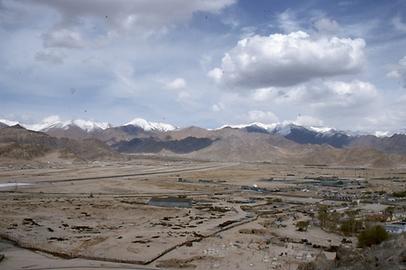


The abbot is each time the re-born Bakula Rimpoche. The Bakula who died in 2004 was of political importance and represented Ladakh in the Indian parliament. After the changeover in the Republic of Mongolia he was the Indian ambassador.


Tibetan Buddhism knows a large number of liturgies and rituals. Summoning, invitation and greetings of gods, worship through music, recitation, material and immaterial offerings, appeasement and calming of fearsome protection gods and thanksgiving are the main elements of the rituals that are performed in the monasteries. There are also mysterious magical practices. Among the most spectacular is a Sang puja, in which Buddhas and Bodhisattvas, protection gods, local deities, mountain gods, element spirits, but also the hungry ghosts of the intermediate realm of Bhavacakra („Wheel of reincarnation“) are called on.
In this ritual offerings of various kinds (tib. sangdze) are burned on a stove. In fire and smoke the summoned gods accept complacently these sacrifices, that melt in flames, smoke and odour. Sacrifices are food, pasta (tib. gtorma), cereal grains, grasses, etc., which are already carefully sorted before the beginning of the ritual next to the stove.



Meanwhile the monks of a higher ranking have taken their seats. Additional to their usual habit they start to put on other vestments such as colourful neck and shoulder collars and so-called Bodhisattva-crowns. In front of their seats are placed liturgical texts, thunderbolts (tib. Dorje) and bells (tib. Drilbu). This all takes place calmly and without haste and hurry.
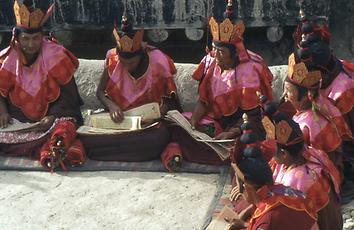




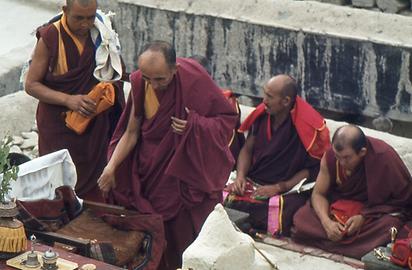






On the stove a large (tib. gangzar) and a small sacrificial spoon (tib. Lugzar) are put down. With the spoons nice-smelling oil is dripped into the flames. The fire is kept burning with dried cowpat a customary repalcement of wood were wood is scarce or unavailable.

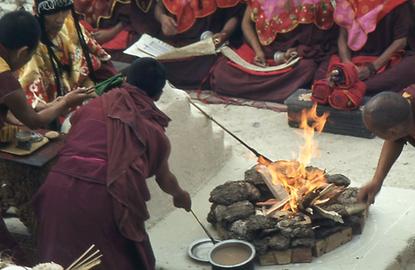
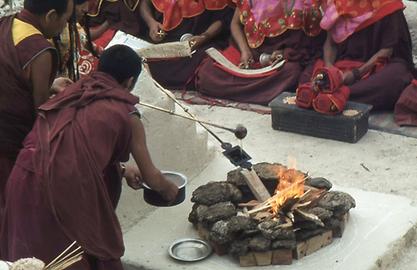

The ceremony is accompanied by oboes (tib. Rgyagling), which are played in pairs.
The ordering parties follow the sacred act in deep reverence.
The parties responsible for the celebrateion follow the sacred act in deep reverence.



